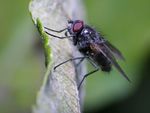Difference between revisions of "Musca spp."
| (3 intermediate revisions by the same user not shown) | |||
| Line 1: | Line 1: | ||
| − | {{ | + | {{OpenPagesTop}} |
| − | |||
{{Taxobox | {{Taxobox | ||
|name = Musca spp. | |name = Musca spp. | ||
| Line 18: | Line 17: | ||
==''Musca autumnalis''== | ==''Musca autumnalis''== | ||
| − | + | Also known as: '''''Face Fly | |
| − | |||
| − | |||
| − | |||
| − | |||
''M. autumnalis'' is found worldwide, and is widely distributed throughout Europe. | ''M. autumnalis'' is found worldwide, and is widely distributed throughout Europe. | ||
| Line 34: | Line 29: | ||
==''Musca domestica''== | ==''Musca domestica''== | ||
| − | + | Also known as: '''''House Fly | |
| − | |||
| − | |||
| − | |||
| − | |||
''M. domestica'' is closely associated with humans and livestock. It is of importance as it mechanically transmits pathogens of real significance e.g. mastitis, and [[Anthrax|anthrax]]. | ''M. domestica'' is closely associated with humans and livestock. It is of importance as it mechanically transmits pathogens of real significance e.g. mastitis, and [[Anthrax|anthrax]]. | ||
| Line 48: | Line 39: | ||
The female lays eggs in faeces and dead rotting material. The eggs then hatch within a day. There are 3 subsequent larval stages and feed upon the faeces. When the larvae mature, they relocate to drier areas, where they form pupae. The pupae will then later mature into adults. | The female lays eggs in faeces and dead rotting material. The eggs then hatch within a day. There are 3 subsequent larval stages and feed upon the faeces. When the larvae mature, they relocate to drier areas, where they form pupae. The pupae will then later mature into adults. | ||
| − | = | + | {{Learning |
| + | |flashcards = [[Nuisance_Flies_Flashcards|Nuisance Flies Flashcards]] | ||
| + | |literature search =[http://www.cabdirect.org/search.html?rowId=1&options1=AND&q1=Musca&occuring1=title&rowId=2&options2=AND&q2=&occuring2=freetext&rowId=3&options3=AND&q3=&occuring3=freetext&publishedstart=2000&publishedend=yyyy&calendarInput=yyyy-mm-dd&la=any&it=any&show=all&x=58&y=12 ''Musca'' spp. publications since 2000] | ||
| + | }} | ||
| − | + | ||
| + | {{review}} | ||
| + | |||
| + | {{OpenPages}} | ||
[[Category:Nuisance_Flies]] | [[Category:Nuisance_Flies]] | ||
| − | + | ||
[[Category:Expert_Review]] | [[Category:Expert_Review]] | ||
Latest revision as of 13:35, 18 July 2012
| Musca spp. | |
|---|---|
| Kingdom | Animalia |
| Phylum | Arthropoda |
| Class | Insecta |
| Order | Diptera |
| Family | Muscidae |
| Genus | Musca |
Musca autumnalis
Also known as: Face Fly
M. autumnalis is found worldwide, and is widely distributed throughout Europe.
Identification
The fly is around 7-8mm in length. It grey in colour and has 4 dark stripes on the thorax. It is very similar in appearance to M. domestica, and has prominant red eyes.
Life Cycle
M. autumnalis feeds on secretions from the nose, mouth, and the eyes, as well as blood from the wounds left by other flies. It lays eggs in cattle manure, which later develop into larvae. The larvae pass through three separate stages, before forming pupae in the soil. Under optimal conditions, they require around 2 weeks to complete the life cycle.
Musca domestica
Also known as: House Fly
M. domestica is closely associated with humans and livestock. It is of importance as it mechanically transmits pathogens of real significance e.g. mastitis, and anthrax.
Identification
M. domestica is around 7mm in length, and grey in colour, with four dark longitudinal shapes. The abdomen is dark yellow in colour, with a black median stripe.
Life Cycle
The female lays eggs in faeces and dead rotting material. The eggs then hatch within a day. There are 3 subsequent larval stages and feed upon the faeces. When the larvae mature, they relocate to drier areas, where they form pupae. The pupae will then later mature into adults.
| Musca spp. Learning Resources | |
|---|---|
 Test your knowledge using flashcard type questions |
Nuisance Flies Flashcards |
 Search for recent publications via CAB Abstract (CABI log in required) |
Musca spp. publications since 2000 |
| This article has been peer reviewed but is awaiting expert review. If you would like to help with this, please see more information about expert reviewing. |
Error in widget FBRecommend: unable to write file /var/www/wikivet.net/extensions/Widgets/compiled_templates/wrt6620e79c04f524_73140057 Error in widget google+: unable to write file /var/www/wikivet.net/extensions/Widgets/compiled_templates/wrt6620e79c084744_84316308 Error in widget TwitterTweet: unable to write file /var/www/wikivet.net/extensions/Widgets/compiled_templates/wrt6620e79c0b6738_90508345
|
| WikiVet® Introduction - Help WikiVet - Report a Problem |
